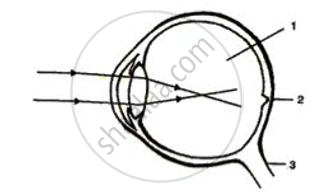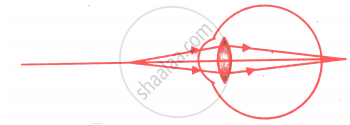Advertisements
Advertisements
प्रश्न
Differentiate between:
Short-sightedness and Long-sightedness.
उत्तर
| Short-Sightedness | Long-Sightedness |
| (i) The inability of the eye lens to focus images of distant objects on the retina; so the images fall in front of the retina. | The inability of the eye lens to focus near object images on the retina; so the images fall beyond the retina. |
| (ii) It is corrected by using glasses of a concave lens. | It is corrected by using glasses of a convex lenses. |
APPEARS IN
संबंधित प्रश्न
List three common refractive defects of vision. Suggest the way of correcting these defects.
What is the far point and near point of the human eye with normal vision?
A student suffering from myopia is not able to see distinctly the objects placed beyond 5 m. List two possible reasons due to which this defect of vision may have arisen. With the help of ray diagrams, explain
(i) why the student is unable to see distinctly the objects placed beyond 5 m from his eyes.
(ii) the type of the corrective lens used to restore proper vision and how this defect is corrected by the use of this lens.
(b) If, in this case, the numerical value of the focal length of the corrective lens is 5 m, find the power of the lens as per the new Cartesian sign convention
Which defect of vision can be rectified:
by using a convex lens?
Your friend can read a book perfectly well but cannot read the writing on blackboard unless she sits on the front row in class.
Is she short-sighted or long-sighted?
A man can read the number of a distant but clearly but he finds difficulty in reading a book.
From which defect of the eye is he suffering?
The near-point of a person suffering from hypermetropia is at 50 cm from his eye. What is the nature and power of the lens needed to correct this defect? (Assume that the near-point of the normal eye is 25 cm).
Distinguish between the following pair of words:
Myopia and hypermetropia
Write whether the following is true or false:
A convex lens is used for correcting myopia.
Given alongside is a diagram depicting a defect of the human eye. Study the same and then answer the questions that follow:
(i) Identify the defect.
(ii) Name the parts labelled 1, 2 and 3.
(iii) Give labelled two possible reasons for this eye defect.
(iv) Draw a labelled diagram to show how the above mentioned defect is rectified.

Given below is a diagram depicting a defect of the human eye? Study the same and answer the question that follow:

Draw a labeled diagram to show how the above mentioned defect is rectified using the lens named above.
The near point of the eye of a person is 50 cm. Find the nature and power of the corrective lens required by the person to enable him to see clearly the objects placed at 25 cm from the eye?
Solve the following question:
The near point of the eye of a person is 50 cm. Find the nature and power of the corrective lens required by the person to enable him to see clearly the objects placed at 25 cm from the eye?
Name the common defects of the eye.
Give Reason:
Deficiency of vitamin A causes night blindness.
Give Technical Term:
The type of lens used to correct myopia is
Complete the following sentence with appropriate word :
An inability to focus on nearby objects due to loss of elasticity of the lens with age is called Iris.
Given below is a diagram showing a defect of vision. Name the defect of vision and draw an accurately labelled diagram to correct this defect.

Myopia and hypermetropia can be corrected by:
